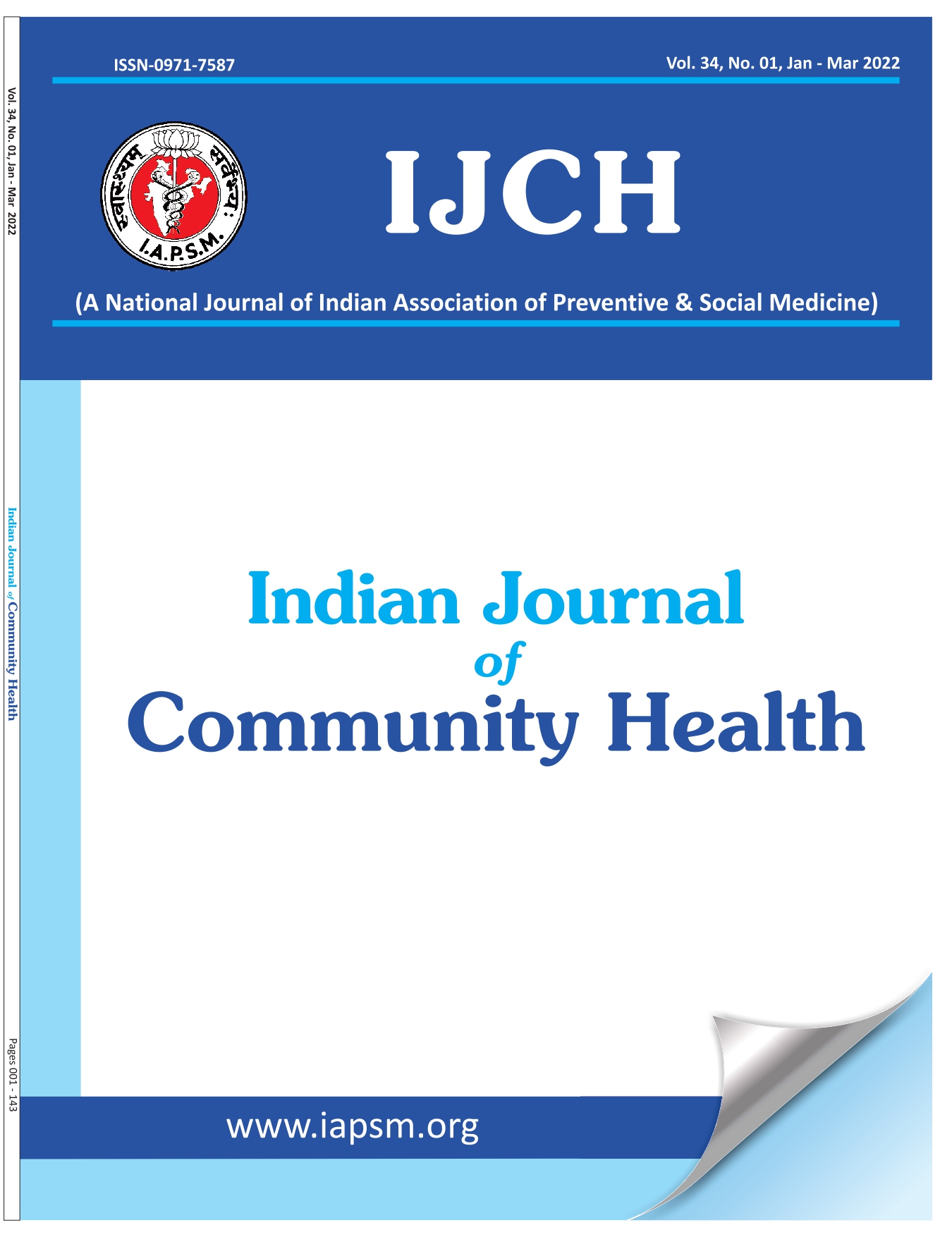The knowledge and attitudes towards domestic violence among pregnant women in Delhi, India
DOI:
https://doi.org/10.47203/IJCH.2021.v33i04.014Keywords:
Domestic Violence, Intimate Partner Violence , Violence Against Women, Antenatal WomenAbstract
Background: Domestic violence during pregnancy endangers the health of the mother and her child. Aim and Objective: To ascertain the knowledge and attitudes towards domestic violence among pregnant women in India and to find out their sociodemographic predictors. Settings and design: This cross-sectional analysis of baseline data from a prospective study was conducted at the antenatal care (ANC) clinic of a major tertiary care government hospital in New Delhi from 2015-2018. Methods and material: The data were collected through face-to-face interviews with 1500 pregnant women up to 20 weeks of gestation. A p-value < 0.05 was considered statistically significant. Results: The mean (SD) age of the participants was 24.6 (3.6) years. All the participants were married. A total of 1169 (77.9%) participants were aware of domestic violence. The participant comprehension of the types of domestic violence was highest for physical (89.9%), emotional (68.4%), economical (21.5%), and sexual (17.4%) violence. On adjusted analysis, education ?10 years and higher SES were associated with a comprehensive awareness of domestic violence. Conclusions: The awareness of domestic violence, especially beyond physical violence, is low among pregnant women in India.
Downloads
References
Violence against women: intimate partner and sexual violence against women. 2020. http://www.who.int/mediacentre/factsheets/fs239/en/
Government of India. The Protection of Women from Domestic Violence Act. 2005 [Internet] Available from: http://legislative.gov.in/sites/default/files/A2005-43.pdf
Devries KM, Kishor S, Johnson H, Stockl H, Bacchus LJ, Garcia-Moreno C, et al. Intimate partner violence during pregnancy: analysis of prevalence data from 19 countries. Reprod Health Matters. 2010;18(36):158–70.
Finnbogadóttir H, Dykes AK, Wann-Hansson C. Prevalence of domestic violence during pregnancy andrelated risk factors: a cross-sectional study in southern Sweden. BMC women's health. 2014;14(1):63.
Berhanie, Eskedar, Dawit Gebregziabher, Hagos Berihu, AzmeraGerezgiher, and Genet Kidane. 2019. "Intimate Partner Violence during Pregnancy and Adverse Birth Outcomes: A Case-Control Study." Reproductive Health 16 (1): 22.
Kastello J, Jacobsen K, Gaffney K, Kodadek M, Bullock L, Sharps P. Posttraumatic stress disorder among low-income women exposed to perinatal intimate partner violence. Arch Women's Mental Health. 2016;19(3):521–8.
Rose, Linda, Jeanne Alhusen, Shreya Bhandari, Karen Soeken, Kristen Marcantonio, Linda Bullock, and Phyllis Sharps. "Impact of Intimate Partner Violence on Pregnant Women's Mental Health: Mental Distress and Mental Strength." Issues in Mental Health Nursing 2010;31 (2): 103–11.
Garcia-Moreno C, Jansen HA, Ellsberg M, Heise L, Watts CH. WHO multi-country study on Women's health and domestic violence against women study team: prevalence of intimate partner violence: findings from the WHO multi-country study on women's health and domestic violence. Lancet. 2006;368(9543):1260–9.
United Nations Development Program. Gender Inequality Index. [Internet] http://hdr.undp.org/en/composite/GII
International Institute for Population Sciences (IIPS) and ICF. 2017. National Family Health Survey (NFHS-4), 2015-16: India. Mumbai: IIPS.
Dasgupta, A., Raj, A., Nair, S., Naik, D., Saggurti, N., Donta, B., & Silverman, J. G. (2018). Assessing the relationship between intimate partner violence, externally-decided pregnancy and unintended pregnancies among women in slum communities in Mumbai, India. BMJ sexual & reproductive health, jfprhc-2017-101834. Advance online publication. https://doi.org/10.1136/bmjsrh-2017-101834
Priya A, Chaturvedi S, Bhasin SK, Bhatia MS, Radhakrishnan G.Are pregnant women also vulnerable to domestic violence? A community based enquiry for prevalence and predictors of domestic violence among pregnant women. J Family Med Prim Care 2019;8:1575?9.
Garg S, Singh MM, Rustagi R, Engtipi K, Bala I. Magnitude of domestic violence and its sociodemographic correlates among pregnant women in Delhi. J Family Med Prim Care 2019;8:3634-9.
Gracia E. Unreported cases of domestic violence against women: towards an epidemiology of social silence, tolerance, and inhibition. J Epidemiol Community Health. 2004;58(7):536-7.
Kalokhe A, del Rio C, Dunkle K, Stephenson R,Metheny N, Paranjape A et al. Domestic violence against women in India: A systematic review of a decade of quantitative studies. Global public health. 2017:3;12(4):498-513
Fernandez M. Domestic violence by extended family members in India: Interplay of gender and generation. Journal of Interpersonal Violence. 1997; 12(3):433–55.
Gundappa A, Rathod PB. Violence against Women in India: Preventive measures. Indian Streams Research Journal. 2012; 2(4):1–4.
Sharma R. Revision of Prasad's social classification and provision of an online tool for real-time updating. South Asian J Cancer 2013;2(3):157.
Weitzman A. Does Increasing Women's Education Reduce Their Risk of Intimate Partner Violence? Evidence from an Education Policy Reform. Criminology. 2018;56(3):574-607.
Sabarwal S, Santhya KG, Jejeebhoy SJ. Women's autonomy and experience of physical violence within marriage in rural India: Evidence from a prospective study. J Interpers Violence .2014; 29(2):332-47.
Shah SH, Rajani K, Kataria L, Trivedi A, Patel S, Mehta K. Perception and prevalence of domestic violence in the study population. Ind Psychiatry J 2012;21:137-43.
National Family Health Survey III. Chapter 15.4, 2005-2006
Kalokhe AS, Potdar RR, Stephenson R, Dunkle KL, Paranjape A, Del Rio C, et al. How well does the World Health Organization definition of domestic violence work for India? PLoS One. 2015;10(3):e0120909.
Downloads
Published
How to Cite
License
Copyright (c) 2021 Indian Journal of Community Health

This work is licensed under a Creative Commons Attribution-NonCommercial-NoDerivatives 4.0 International License.





